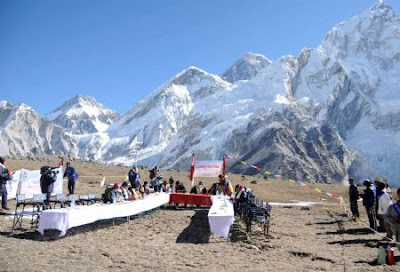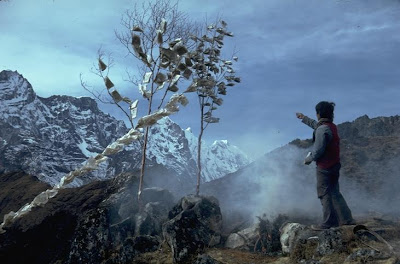On crying "Himalayan Meltdown!!!"
When the Himalayas make headlines, it's generally not a good thing. Sure, the world celebrated the conquest of Everest ("We knocked the bastard off," gloated Edmund Hillary), but since then it's been one crisis after another. Wall-to-wall deforestation, garbage Armageddon, glacial lake outburst floods, traffic jams on Everest, and now meltdown. Tourism plummets as postcard views disappear into thin air; drought racks the Subcontinent; millions die. As Hillary put it, "It's all bullshit on Everest these days."
Sir Edmund was referring to the commercialization of Himalayan mountain climbing, but, if he were alive he might have said as much about this current controversy.

Everest
The flap this time concerns an assessment in the most recent report of the Intergovernmental Panel on Climate Change (IPCC), a UN panel that, incidentally, shared the 2007 Nobel Peace Prize with Al Gore. At the Copenhagen summit last December, the IPCC Fourth Assessment Report: Climate Change 2007, served as the basis for proposals to make drastic cuts in global emissions. It also included a statement that glaciers would most likely disappear from the Himalayas by 2035.
It turns out that the prediction was wrong, and that IPCC Chair Dr. Rajendra Pachauri knew that it was wrong. "Climate fraud!" screamed the global-warming denialists. "Glaciergate!" The Times of London (Jan. 30, 2010) noted that Pachauri had "been accused of using the error to win grants worth hundreds of thousands of pounds."
Since much of the flap revolves around issues of documentation, we should look at the wording of the assessment in question. I should point out, also, that none of the following account represents my own research. There have been numerous articles on the subject, both in mainstream media (including BBC and The Times), as well as the blogosphere (notably, right-wing hatcheteers such as Buy The Truth and Skeptics Corner). Wikipedia has a synoptic article on the issue as well.
The 2007 IPCC report includes four sub-reports. The contribution of Working Group II ("Impacts, Adaptation and Vulnerability") includes the following:
Glaciers in the Himalaya are receding faster than in any other part of the world (see Table 10.9) and, if the present rate continues, the likelihood of them disappearing by the year 2035 and perhaps sooner is very high if the Earth keeps warming at the current rate. Its total area will likely shrink from the present 500,000 to 100,000 km2 by the year 2035 (WWF, 2005).
— WGII, chapter 10, page 493
NB: "High likelihood" is defined by the IPCC as greater than 90% confidence.
Apparently, the IPCC's internal rules specify that reports should be based on published, peer-reviewed scientific studies. (The IPCC itself does not carry out research.) Exceptions are possible, but involve further in-house reviews; this paragraph is not such an exception. The assessment is attributed to World Wildlife Fund's March 2005 Nepal Program report, which contains the following sentence:
In 1999, a report by the Working Group on Himalayan Glaciology (WGHG) of the International Commission for Snow and Ice (ICSI) stated: “glaciers in the Himalayas are receding faster than in any other part of the world and, if the present rate continues, the livelihood [sic] of them disappearing by the year 2035 is very high”.
— WWF p. 29
The WWF report is not a peer-reviewed scientific paper, and should not have been cited as the sole source for such an inflammatory claim. But what about the WGHG/ICSI report? The WWF cited that report (which actually had not been published) via an article by Fred Pearce, senior environment correspondent for the generally respected New Scientist (June 5, 1999); the article was based on a brief telephone interview with ICSI Chair Syed Hasnain in which Hasnain was purported to have said that the "four-year study indicates that all the glaciers in the central and eastern Himalayas could disappear by 2035 at their present rate of decline." Hasnain's unpublished study actually does not include a date for the anticipated decline of Himalayan glaciers, and he has recently stated that his telephone comment was pure speculation, without any basis in scientific research.
As for the IPCC paragraph, which began "Glaciers in the Himalaya are receding faster than in any other part of the world," Hasnain had said nothing about the comparative rate of shrinkage of the Himalayas, nor had he mentioned the surface area covered by glaciers.
So where did that second sentence of the WGII paragraph come from? In a letter to the journal Science (Jan 20, 2010), Cogley et al report a likely source:
In the second WG-II sentence, 'its' cannot refer to Himalayan glaciers [area about 33,000 km2], and may refer to the world total area of glaciers and ice caps. A bibliographic search suggests that the second WG-II sentence is copied inaccurately from [a 1996 paper by V. M. Kotlyakov], in which the predicted date for shrinkage of the world total from 500,000 to 100,000 km2 is 2350, not 2035.
sciencemag.org
So, the IPCC screwed up -- in that paragraph. There are probably other screw-ups in their reports. But the basic thrust of their 3000-page report is accurate: global climate change is real, it is the result of human impact, and it is happening much faster than expected. IPCC Chair Raj Pachauri's response to queries and criticism poured oil on the fire. When the Indian Ministry of Environment and Forests published a study arguing that there is not enough evidence to connect glacial warming with Himalayan deglaciation, Pachauri immediately dismissed the report as “voodoo science.”
The right-wing pile-on has been impressive. The basic message has been (to paraphrase Sir Edmund) "It's all junk science." Glaciergate has been used to cast doubt on the entire liberal agenda, from climate change to evolution to health care reform. A nice example: the IPCC blunder was featured in an amendment to a petition served on the Environmental Protection Agency (docket #EPA-HQ-OAR-2009-0171) by a gaggle of Republican congresspeople (including Birth/Deather Michele Bachmann) and a posse of automotive corporations and loggers, the aim of which is to force the EPA to renounce policies designed to restrain climate change.
One of the recurrent themes in this controversy, also featured in the EPA suit, is that the IPCC must have known all along that there was well-founded scientific argument against the Himalayan meltdown forecast because of the work of Jack D. Ives. Jack Ives was my thesis advisor at the University of California, Davis, and is my mentor, friend, and collaborator. The article most cited in this connection, "Himalayan misconceptions and distortions: What are the facts?" appeared in the peer-reviewed Himalayan Journal of Sciences, for which I happen to be an editor. [HJS Vol 3, No. 5, p. 15-25; available at
http://www.nepjol.info/index.php/HJS/article/view/457/447]

Jack Ives at biodiversity conference in Kathmandu (1999)
For years, Ives has been warning that the habit of distortion and exaggeration was undermining both science and development. In Himalayan Dilemma: Reconciling Development and Conservation (1989) Ives took aim at the so-called Theory of Himalayan Environmental Degradation, a popular construct that supported projections of catastrophic deforestation. More recently, particularly in Himalayan Perceptions: Environmental Change and the Well-being of Mountain Peoples (2004), he has urged caution on the subject of Glacial Lake Outburst Floods (GLOFs). Ives has not denied that deforestation, GLOFs, and glacial thinning are problems. He has simply argued that in many cases there is insufficient evidence to establish causalities and projections, and that the misidentification of a crisis or a pseudo-crisis as a supercrisis not only wastes limited resources but also undermines the credibility of science in general. And, coincidentally, Ives has repeatedly singled out Fred Pearce of the New Scientist as a purveyor of unsubstantiated mega-disaster scenarios.
Well, those chickens have come home to roost.
So, while it is flattering to have a lot of bloggers fluffing up the reputation of our little journal and of our friend Jack Ives, we've got to keep in mind that the fluffers are basically the same crew as the tea-baggers, creationists, and corporate tools. They are no friends of science, much less of the Himalayas.
But ... what about the Himalayas?
First of all, Himalayan meltdown is a story with legs. In November, 2004, a petition signed by many distinguished experts and stakeholders was presented to UNESCO; it appealed for intervention to save Mt. Everest from global warming. Last fall, the Nepali parliament held a photo-op session at Mt. Everest Base Camp to dramatize this appeal. So we're not just talking about an isolated unfounded speculation that made its way into an IPCC report.

Xin Hua (Chinese news agency) photo of the "Nepalese Parliament at Everest Base Camp" (actually, they're at Gorak Shep, several hours' trudge southwest of Base Camp)
Secondly, it is true that glaciers around the world are thinning and even (in some cases) disappearing. This represents an acceleration of a trend that started with the end of the Little Ice Age, a period of global cooling from around 1550 to 1900. The general trend is well documented with measurements and replicate photography. On the other hand, some glaciers are actually growing. The dynamics of glaciation are complicated, and much study is required before we can make competent projections.
Now, setting aside all caution, and all lessons that might be learned from the IPCC debacle, let's talk about the future of the Himalayas.
It is safe to say that the Himalayan glaciers will not disappear by 2035, or even by 2100. Many of them are hundreds of meters thick, and the rate of shrinkage would have to increase explosively to wipe out monster glaciers like those tumbling into the Everest cirque. More to the point, every glacier has an accumulation zone and an ablation zone. The ablation zone, where glaciers thin out and die through melting and sublimation, may expand uphill a bit, but the lapse rate -- the decline of temperature with altitude -- is controlled by physics. Temperature falls by 6.49°C/1,000 m (3.56°F/1,000 ft). Global warming for the twentieth century is put at 0.74 ± 0.18°C (1.33 ± 0.32 °F): not even enough to move the firn line 200 meters uphill. Very little glacial thinning has been observed or is expected above 5,500 meters, which leaves quite a bit of ice on those 7000- and 8000- meter giants.

Glacier mushrooms at Everest Base Camp: rock cap protects the ice neck of
the mushroom, as the rest of the glacier melts sublimates or melts. These
shots were taken in 1982 -- I didn't see any there on later visits.
What is most likely is that at lower levels the increased glacial movement will make mountain climbing a bit more risky. Surface meltwater tends to work its way down, and "wetbased" glaciers tend to skid along at distinctly non-glacial speed. The Khumbu Icefall, between Base Camp and Camp One, will certainly become more dangerous. Of course, even if the glaciers were to disappear completely (which they won't), the mountains will still be there. It may become harder to "knock the bastard off," which may cost Nepal some climbing fees. Or not. Mountain climbers seem to have a taste for danger, don't they?
In fact, global warming will result in more evaporation, increasing snowfall at high elevations and also increasing atmospheric and land albedo (clouds and snow), thereby reflecting away from Earth a greater proportion of incident sunlight, which would otherwise be transformed into heat.
What about the highland-lowland linkages? Glacial lake outburst floods? Drought? Insufficient water for irrigation and drinking? GLOFs are certainly a hazard, and there will be more in the short term -- but there is no data to support predictions of millions of deaths. Rather, they seem to be relatively local phenomena, likely to cause dozens, or perhaps hundreds, of deaths -- not millions, as some have speculated. And, once the terminal moraines are flushed away, large lakes are not likely to accumulate in positions where they can break out suddenly.
The contribution of Himalayan glaciers to lowland water systems has not been adequately studied. The ice certainly serves as a reservoir, collecting precipitation and assuring a year-round flow of meltwater. On the other hand, much of the subcontinent is impacted by summer monsoons, which make a far greater contribution to the water supply than distant glaciers, although that contribution is significant during the dry seasons before and after the monsoon. Again, increased temperatures will mean increased precipitation, and with decades to adjust, there is no reason to believe that lack of water would be a major issue.
Ironically, the scale of change that would cause glacial meltdown in the Himalayas would most likely be great enough to bring on a cascade of unpleasant intermediary developments well before the disappearance of Himalayan glaciers. Ocean waters would rise enough to wipe out Bangladesh, for instance. Of course, UNESCO would have other fish to fry at that point: Venice, the Everglades, and quite a few other World Heritage Sites would be in the drink. The carbon dioxide driving the global warming would also acidify the oceans, wiping out ecosystems and human food supply. The North American groundwater, a relic of the Wisconsin-Wurms Ice Age, would have run dry; this groundwater is the motor that powers the cold current in the North Atlantic which in turn drives the Gulf Stream. Without the Gulf Stream, the higher latitudes in the northern hemisphere would become much colder, and the lower latitudes much warmer.

Stupa in honor of Tenzing Norgay
Which brings us quickly to the real issue. We are never very far from the next ice age. If that seems a distant prospect, perhaps you still conceive of an ice age as something which creeps down from the north as if someone were pulling down the shades. As I learned in Jack Ives' Physical Geography 101, the evidence supports "instantaneous glacierization": little patches of snow fail to melt one summer, build up a bit over the next few years, and soon reach an elevation cold enough to sustain snow all year round. These passages have a refrigerating effect on the local area, propagating new snow patches, which expand and merge and voila! No more global warming!
Of course, another negative feedback loop eventually kicks in, and global warming sets in, with a new IPCC to warn us about deglaciation.
So, yes, the climate is changing and it's in large part our fault. Petitions and Base Camp photo-ops may help some people feel like they're doing something about it. But, in the short run at least, the larger problem is the bullshit. If we let the Glenn Becks and Sarah Palins convince the world that it's all junk science out there, we'll be up the proverbial creek without the one paddle that can actually save us.

Sherpa boy dedicates a prayer flag tree
Seth Sicroff, Nepal Editor for Wandering Educators
Manager, Sunrise Pashmina
Feature photo: Seth Sicroff in front of Pumori (photo by Vera Hildebrand)
All photos courtesy and copyright of Seth Sicroff, except where noted
-

- Log in to post comments



















